馬上註冊,結交更多好友,享用更多功能,讓你輕鬆玩轉社區。
您需要 登錄 才可以下載或查看,沒有賬號?註冊
x
Introduction This is a list of Nikon's best lenses of all time, especially those which set new standards. For suggestions of the best lenses to get today, see: Suggested lenses for DX SLRs Suggested Lenses for FX and Film SLRs The Nikon FX Dream Team More FX Lens Suggestions Nikon Cheapskate FX Lenses Now back to the 10 best lenses of all time. For a lens to be great, it has to serve a purpose and be easy to use. Great optics alone aren't enough. All of Nikon's and Canon's ultra-teles, mid-teles, f/2.8 zooms and macros have superb optics, but we expect that. You don't need me to list them again here. To make it to this list, a lens has to astound. It has to be far better than we expect. If a cheap plastic lens has great optics, it's far better than a $1,800 lens that's as good. These are in no particular order. All cover FX, DX and film unless otherwise noted. Click the lens pictures (or links) to get to their individual reviews. Don't forget to read the even funnier Nikon's 10 Worst Lenses.
50mm f/1.8D AF (versions from 1978 - today) 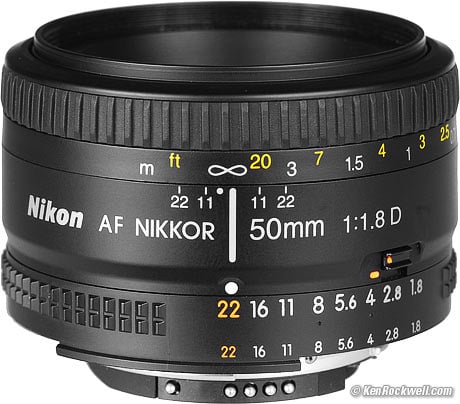
Nikon 50mm f/1.8 D. Nikon's least expensive lens is also among its sharpest. It has no distortion, focuses almost instantly, and it's Nikon's smallest and lightest lens. It is among Nikon's fastest lenses, and covers film and the full FX frame. Except that the D40, D40x and D60 can't autofocus with it (neither can the F3), there is no reason not to own one of these, unless you opt for the twice as expensive 50mm f/1.4 D. All the earlier 50mm f/1.8 lenses since 1978 are also all excellent, including the 50mm f/1.8 AF (non-D), 50mm f/1.8 Nikkor manual focus, and the 50mm f/1.8 Series E.
24mm f/1.4 AF-S G (2010-today) 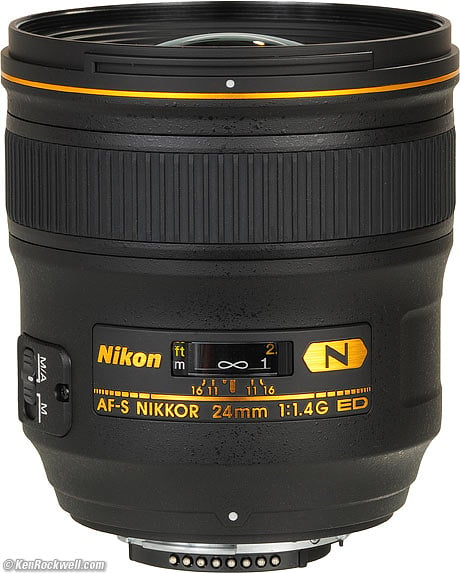
Nikon 24mm f/1.4 AF-S G. Nikon's newest lens is among their best. This is not only the world's best 24mm lens, significantly better optically than the LEICA SUMMILUX-M 24mm f/1.4 that costs three times as much, it's also an extremely useful lens. If low light is your interest, I'd suggest getting this 24mm f/1.4 instead of a wide zoom. For many people, this could be the only wide lens you'd ever need. Its performance is unequalled at any aperture. Because it has half the focal length of a 50mm lens, it can be hand-held at for exposure times twice as long. This lets me shoot hand-held in light twice as dim as with a 50mm f/1.4 lens, or in the same light as a 50mm f/1 lens. Unlike a 50mm lens, it has far more depth of field at the same f/stop. This additional depth of field also contributes to sharp hand-held photos at night. This 24mm lens at f/1.4 has a useful depth of field, while 50mm f/1.4 lenses have only paper-thin depths of field.
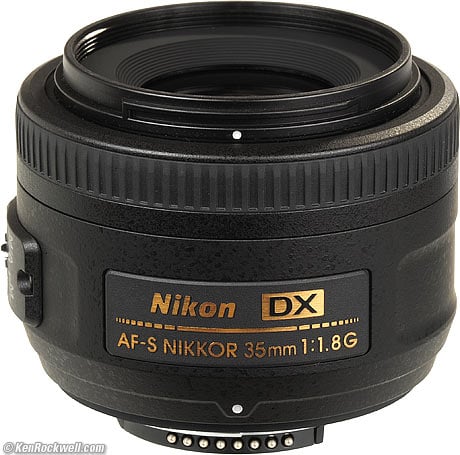
Nikon 35mm f/1.8 DX. This $200 lens is a steal. It's my favorite DX lens. The 35mm f/1.8 is super-sharp, focuses instantly, it's fast, it's tough (metal mount), and simply works perfectly. What more can I say? Get one before Nikon catches on and raises the price.
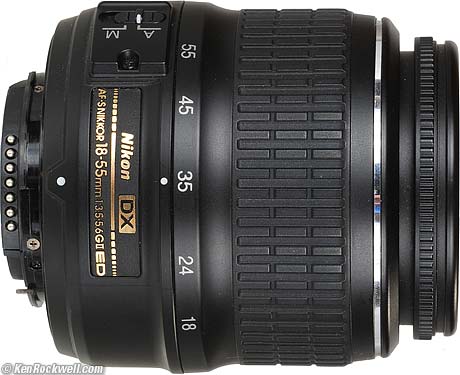
Nikon 18-55mm f/3.5-5.6 DX. Even as a cheap, plastic lens, the 18-55mm is sharp, sharp, sharp, and focuses so close that few people will need a dedicated macro lens. Included as a kit lens with Nikon's cheapest cameras, lenses this good and this cheap ask us what would happen if Nikon put some of this same mojo into its more expensive lenses. It only covers DX digital; it can't cover film or FX.
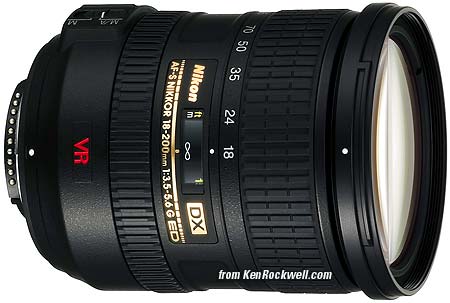
Nikon 18-200mm VR DX. The 18-200mm VR is the freedom lens. It is the lens which let me get rid of the old fashioned "camera bag" photographers used to have to carry. The 18-200mm VR replaces all the lenses we used to haul around. The only thing it doesn't do is replace an ultra-wide lens like the 12-24mm DX, or allow us to shoot sports in dim light like the 70-200mm VR. If you need anything longer, you'll get better photos by getting closer with the 18-200 VR than you will by using a longer lens like the 600mm VR. Back in the days of DX cameras, the 18-200mm let me just go and shoot, and not have to carry other lenses or have to change them in a middle of a shoot.

Nikon 135mm f/2 DC AF Americans just don't get this lens, because Nikon messed up its name. The 135mm DC, or "Defocus Control," lens, is among Nikon's sharpest lenses ever. Defocus control doesn't mean soft focus, it means "background softness control." The DC feature is really Bokeh optimization. The DC feature always keeps the subject ultra sharp, and allows the photographer to defocus just the background (or foreground) into the softest, smoothest, dreamiest and creamiest pastels ever. The 135mm DC is Nikon's best hand-held portrait lens ever, as well as a killer-sharp 135mm lens for everything.

Nikon 14-24mm f/2.8 AF-S. The big, heavy 14-24mm f/2.8 AF-S just rewrote the book on ultra-wideangle lens performance. It raises the performance bar about 20 years ahead of every other ultra-wideangle SLR lens. The 14-24mm is sharp, sharp, sharp, even wide open, and even in the corners. It's so good that people are buying special adapters just to use them on Canon cameras! The 14-24mm is excellent on amateur DX cameras like the D300, but doesn't really start pumping until you use it on film or a full-frame FX digital camera. I've shot a lot of fixed 24mm, 20mm, 18mm, 17mm, 15mm and 14mm lenses in my days, and this zoom smokes them all. It lets me do things I never could, like jump into a dark, abandoned building without a tripod, shoot away at f/2.8 and high ISOs on a D3, and get out with excellent photos for which I don't need to make any excuses.
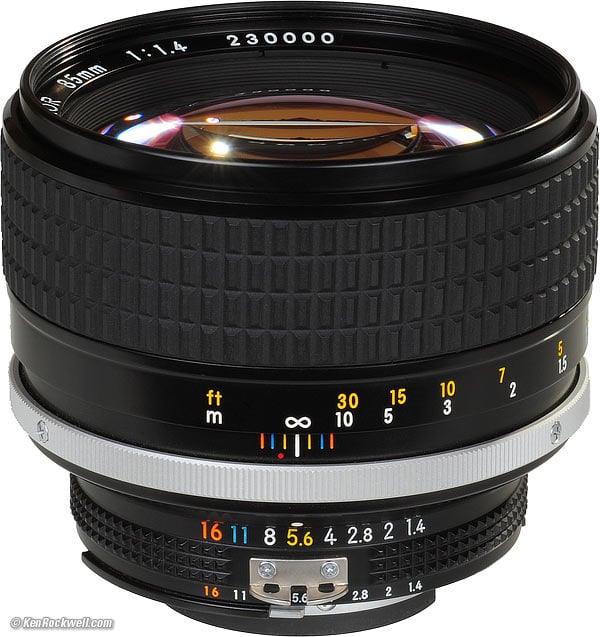
Nikon 85mm f/1.4 AI-s. The optics of most of Nikon's earlier AI-s manual focus lenses have been exceeded in Nikon's newer AF lenses. This isn't the case here. This manual focus lens outperforms its newer 85mm f/1.4 D autofocus sibling. In fact, its so good that even after the f/1.4 autofocus lens came out, for about the about the same price, Nikon kept making these for 10 more years! It's sharper than the new AF lens, and it has much better bokeh than most other Nikon lenses. If I'm photographing moving people and kids, of course I'll prefer the AF lens, but if I'm hugging a tripod, the King is still the King.
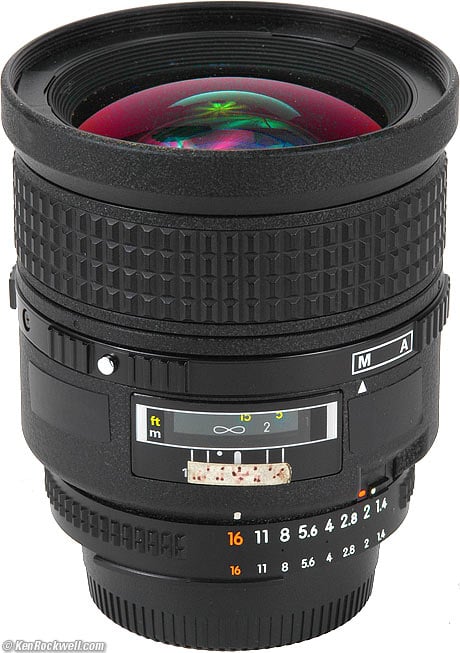
Nikon 28mm f/1.4 D AF. (blacked-out for national security purposes) Nikon spent ten years perfecting this masterpiece, then discontinued it in 2006 from lack of market interest due to its deservedly high price. Collectors finally figured it out, and they now sell used for double what they sold for new. This lens is special because its sharp, even in the corners, even wide-open at f/1.4. It is worlds better than today's 35mm f/1.4 (which is a manual focus lens made since 1969) or the manual focus 28mm f/2. This lens allowed me to shoot things hand-held on ISO 50 film that otherwise I could not.
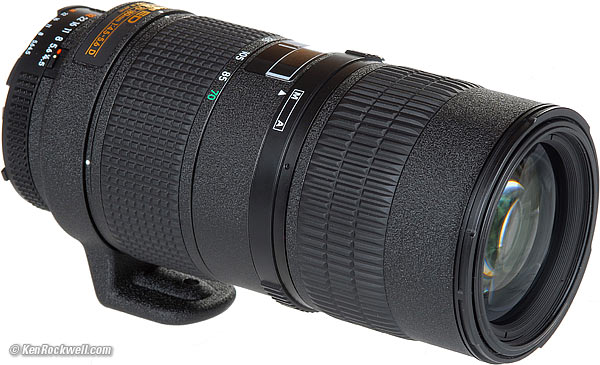
Nikon ED 70-180mm f/4.5-5.6 D AF Micro. Another lens so great that the market never figured it out, this is the only true zoom Micro (macro) lens ever made by Nikon. It also sells used for more than it sold for when new. Unless you're photographing stamps, which makes you silly because you'll get better images sticking them in a scanner, shooting macro is a real pain having to move in and out all the time to frame products and chasing moving subjects like poisonous snakes. I know snake guys who pack heat to protect their 70-180mm lenses; these lenses are that good and irreplaceable. All of my recent product shots, like half the shots on this page, are shot with this lens.
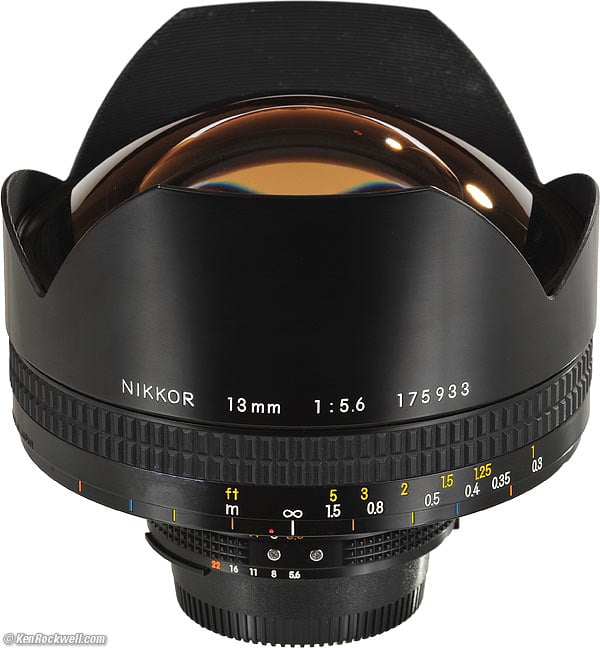
Nikon 13mm f/5.6. enlarge. The 13mm f/5.6 was the world's widest lens when it was introduced, and is still the widest non-distorting professional SLR lens ever made in all of history. It covers FX; a DX lens would need a focal length of just 8.5mm to cover the same ultra-ultra wide angle! 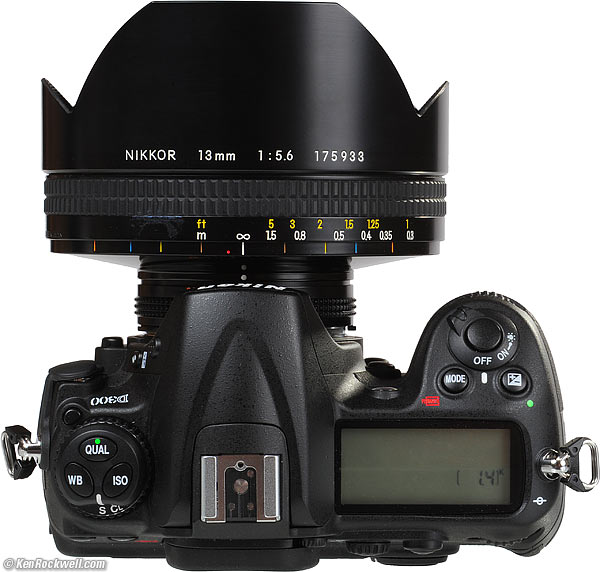
Nikon 13mm f/5.6 swallowing a D300. This beast is big and heavy: 5 inches (12cm) around and it weighs 3 pounds (1.4kg) with caps. The 13mm is not a fisheye. Straight lines stay straight. In fact, just to show off, the 13mm has less distortion than zooms or most other normal and wide lenses! Drop a ruler on lines in the image, and they're straight. It was made back when Nikon was still great enough and crazy enough to make things just because they could. It always cost a significant fraction of what the average American family earns in a year, and used ones today sell for about the same real price as when new: about $5,000 to $20,000. I lusted after the 13mm ever since I was a kid in the 1970s. I saw one on display at Nikon House in Rockefeller Center in New York City in the 1970s, and saw one again in early 2008, from which I'll be penning a review one of these days. Nikon only made these to special order, and only made a few hundred of them across 20 years. Customers who took factory delivery in Japan were treated to a ceremony where the lens was blessed by a Shinto priest. I've only seen two in my life, both in captivity, and never seen one in the field. Sigma makes an inexpensive 12-24mm zoom that may be wider, but it's not a professional lens, its not a Nikon lens, and it distorts slightly. Nikon's 14mm f/2.8 and 14-24mm AF-S are not quite as wide, and have more distortion. This 13mm is also unusual in that it has little to no distortion of straight lines. Unlike zooms and most fixed lenses like the current 14mm f/2.8 and 14-24mm AF-S, make a photo of the horizon along the bottom or shoot a brick wall, and everything stays straight and square. Of course even the slightest tilt on your part throws everything into a bizarre angular array of converging and diverging lines, but that's the fun. Don't expect ever to see one of these, since production was so low. Just get the 14-24mm AF-S , which is a lot less expensive, two stops faster and a lot sharper.
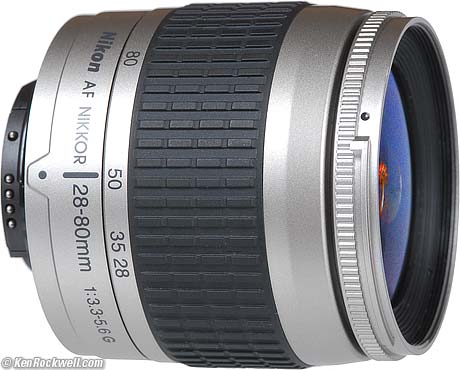
Nikon 28-80mm G, in ghastly silver. 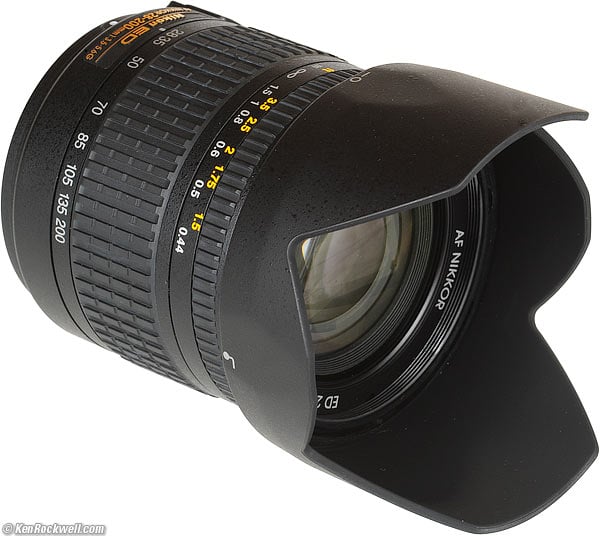
Nikon 28-200mm G These are very inexpensive plastic-mount lenses that came out in 2001 and 2003 for sale with Nikon's cheapest film cameras like the N55 and N75. No one paid any attention, because everyone was swapping over to digital cameras faster than Nikon guessed, leaving Nikon stuck with pallets of unsold N75s. These two lenses incorporate every trick Nikon has learned over decades and decades of lens design and volume manufacturing. Each uses aspherical elements to improve performance and reduce size and weight. Both are sharp, even in the corners. Even the 28-80mm G is sharper than the far more expensive 24-120mm VR, which made my 10-Worst list. Each of these lenses isn't quite as sharp as Nikon's best, but pretty darn close. What gets them on my Best list is that they are this good at such a low price, and that they are tiny and weigh nothing for easy carrying. The 28-200mm G is a miracle. Not only is it pretty sharp in most cases, what gets it on my Best list is that it focuses so closely at every focal length. It focuses down to 17 inches (43cm) at every focal length, much closer than any other Nikon tele, ever. Most teles, like the 135mm DC, often can't focus closely enough for photos of baby heads. This 28-200mm does. The AF isn't that fast since it covers such a wide range, but its fast enough. The 28-80mm G focuses more closely than other Nikon lenses, often eliminating the need for a macro lens. It autofocuses faster than any other Nikon AF lens, including the AF-S lenses. Just try one; it's uncanny how instantly and exactly it focuses. If I want a "do everything" lens for my D3 or D700, it's not the 24-120mm VR. It's the plastic 28-200mm G.

Nikon Zoom-NIKKOR 80-200mm f/4.5n AI. Selling today for $35 at garage sales, or not more than $199 at dealers, this unassuming tele zoom just happens to be the sharpest tele zoom I've ever tested. In my 105mm center, 200mm center, 105mm corner and 200mm corner sharpness comparisons, it's the most consistent performer. All Nikon's 80-200mm f/4.5 zooms are excellent. I found the best is this AI "n" (new) version, which is recognized by the black rectangular plate on its rear mount. The zoom and focus are supposed to be loose and slippery. This was the sports and action lens of its day. No one was silly enough to shoot zooms on tripods pointed down, so creep wasn't the issue. This Nikkor lens was made with such incredible precision that it didn't need to be pumped full of grease to fill up the internal slop of cheaper lenses of its day. It is so well made that it works with little or any lubrication, so it can work in temperature extremes and needs only a tiny flick to move the settings. Notice how it moves so easily, but that there is no play in any of the movement.
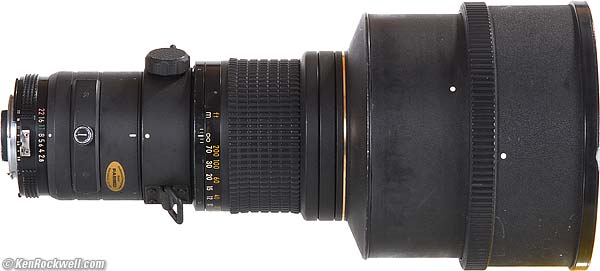
Nikon NIKKOR 300mm f/2.8 ED-IF. Nikon's first internal-focusing 300mm /2.8 lens of 1977 quickly became the news and sports photographers standard long lens. It was fast enough to shoot indoor sports, and the internal-focusing design let it focus from near to far with the flick of a finger. The ED glass allowed superb optical quality in a super-speed long lens. See the Nikon NIKKOR 300mm f/2.8 ED-IF review, and the History of Nikon 300mm f/2.8 lenses. Today, this lens' sprit lives on in the Nikon N AF-S NIKKOR 300mm f/2.8G ED VR II. | 



